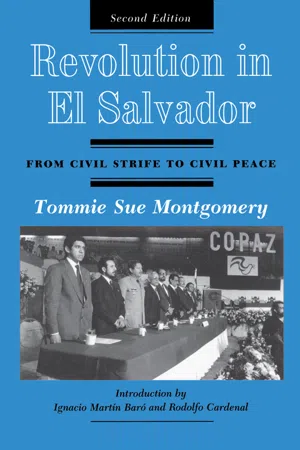
Revolution In El Salvador
From Civil Strife To Civil Peace, Second Edition
- 344 pages
- English
- ePUB (mobile friendly)
- Available on iOS & Android
About This Book
Since the first edition of this book appeared in 1982, El Salvador has experienced the most radical social change in its history. Ten years of civil war, in which a tenacious and creative revolutionary movement battled a larger, better-equipped, US-supported army to a standstill, have ended with 20 months of negotiations and a peace accord that promises to change the course of Salvadorean society and politics. This book traces the history of El Salvador, focusing on the oligarchy and the armed forces, that shaped the Salvadorean army and political system. Concentrating on the period since 1960, the author sheds new light on the US role in the increasing militarization of the country and the origins of the oligarchy-army rupture in 1979. Separate chapters deal with the Catholic church and the revolutionary organizations, which challenged the status quo after 1968. In the new edition, Dr Montgomery continues the story from 1982 to the present, offering a detailed account of the evolution of the war. She examines why Duarte's two inaugural promises, peace and economic prosperity could not be fulfilled and analyzes the electoral victory of the oligarchy in 1989. The final chapters closely follow the peace negotiations, ending with an assessment of the peace accords, and evaluate the future prospects for El Salvador and for the 1994 elections.
Frequently asked questions
Information
1
The Roots of Revolution, 1524–1960
The Bottom Line
| Land size (square kilometers) | 20,935 |
| Population (1993) | 5.4 million |
| Population density (1991 per square kilometer) | 256.8 |
| Average annual rate of growth (1970–1980) | 4.2% |
| (1982–1991) | 1.6% |
| Percent urban (1979) | 40.2 |
| (1988) | 48.2 |
| Percent literate (1984) | 66.9 |
| Urban (1979) | 82 |
| Rural (1979) | 47 |
| Landless | 34 |
| Female | 59 |
| Male | 65.5 |
| Birthrate per 1,000 inhabitants (1978) | 39.7 |
| (1980–1985) | 38.0 |
| (1990) | 32.9 |
| Mortality rate per 1,000 inhabitants (1978) | 6.9 |
| (1980–1985) | 10.8 |
| (1990) | 7.7 |
| Infant mortality per 1,000 live births (1977) | 59.5 |
| (1980–1985) | 77.0 |
| (1990) | 52.9 |
| Years of life expectancy at birth (1979) | 62.2 |
| (1980–1985) | 57.1 |
| (1990) | 66 |
Historical Patterns
- An economic cycle of booms and depressions that replayed itself as variations on a theme several times between the sixteenth and nineteenth centuries
- Dependence on a monocrop economy as the key to wealth, a focus that led to dependence on outside markets
- Exploitation of the labor supply, first the Indians and later the peasants
- Concentration of the land in the hands of an ever-decreasing number of proprietors
- Extreme concentration of wealth in few hands, coupled with the utter deprivation of the overwhelming majority of the population
- A laissez-faire economic philosophy and an absolute belief in the sanctity of private property
- A classical liberal notion of the purpose of government—to maintain order
- Periodic rebellion by exploited segments of the population against perceived injustices
Conquest and Settlement
The “Keys to Wealth”
- Discovery of a new crop
- Rapid development of the crop
- Period of great prosperity from the export of the crop
- Dramatic decline or stagnation
- Economic depression during which a frantic search for a replacement ensued
- Discovery of a new crop and the beginning of another cycle
Enduring Patterns
Table of contents
- Cover
- Half Title
- Title
- Copyright
- Dedication
- Contents
- List of Tables and Illustrations
- Acknowledgments
- Introduction—Fifteen Years Later: Peace at Last
- Prologue: Recollections and Reflections—Fifteen Years in El Salvador
- 1 The Roots of Revolution, 1524–1960
- 2 Challenges to Power, 1960–1980
- 3 The Church
- 4 The Revolutionaries
- 5 Descent into Anarchy; 1980–1982
- 6 High-Intensity Politics and Low-lntensity Conflict, 1982–1984
- 7 Electoral Authoritarianism and the Revolutionary Challenge, 1984–1989
- 8 The Road to Peace, 1989–1994
- Epilogue: The Electronic Tamale
- Notes
- Glossary
- List of Acronyms
- Bibliography
- About the Book and Author
- Index